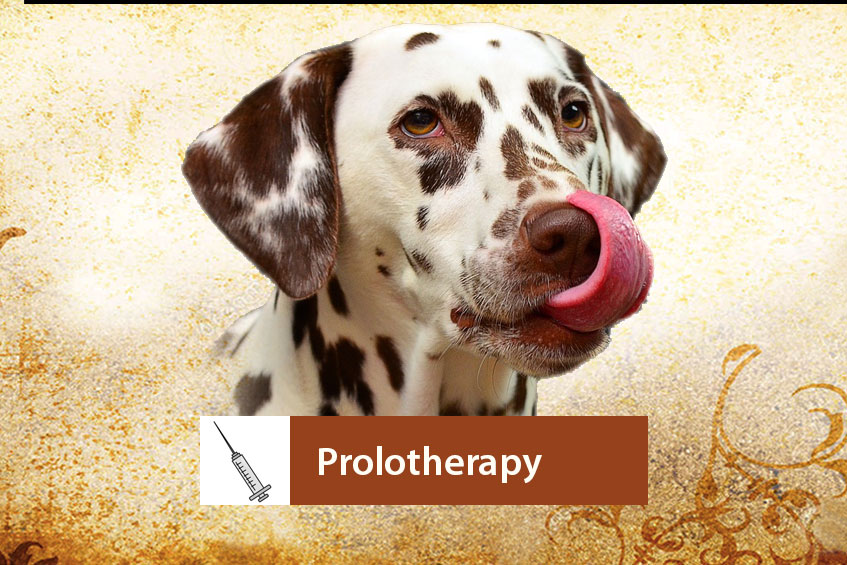Prolotherapy
Prolotherapy
Chronic pain from injury to tendons and ligaments are a common problem in the world of small animals (dogs and cats). Mostly, we call these soft tissue injuries and manage them with non-steroidal anti-inflammatories and rest.
The tendons and ligaments are usually strong bands of connective tissue but they are poorly supplied with blood vessels. After injury, healing is incomplete therefore they become weaker and are a source of constant pain.
Tendons and ligaments are weakest where they join the bone and therefore very prone to injury. Damage to these structures are also very painful as they contain the highest receptors for pain next to the outer lining of the bone called the periosteum. Damage to tendons and ligaments also causes loose joints, the body tries to compensate by forming calcifications in these areas leading to arthritis / osteo-arthritis.
When tendons are completely ruptured, surgery is the best option. However for a partial tear of the ligament as in the cranial cruciate ligament or if the client cannot afford surgical intervention, I offer the option of prolotherapy.
Prolotherapy involves injection of sterile solutions into tendons, ligaments or joints which has the following effects: It increases collagen formation, it triggers the release of growth factors. It causes local stem cells to proliferate and differentiate into the cells necessary for healing.
The prolotherapy injection solutions can include dextrose, vitamins and homeopathic solutions. A small quantity of local anesthetic is included to reduce the immediate discomfort of the injection, and prevent “wind-up” pain, which occurs when nerve cells are stimulated and continue signalling pain even when the source of injury is gone. The healing effect is a graded, controlled reaction producing repair of weak and damaged connective tissue.
When properly applied, prolotherapy does not induce scar formation. The bonds in the connective tissue are stronger and healthier, and the tissue is thicker than before treatment. With each treatment, tissues continue to strengthen until the healing is complete and the pain resolved. Joint laxity decreases due to a strengthening and tightening of the treated tendons and ligaments. This reduces or eliminates pain from muscle spasms and also reduces the need for the body to produce excess bony tissue to assist stabilization, as occurs in osteoarthritis.
Since the injections need to be placed with great accuracy, and may cause temporary discomfort, most dogs and cats will require a sedative for the procedure, and some may need a short general anaesthetic. The typical hospital stay is half a day. The injections can be placed into multiple locations at one session, and usually a series of three to five sessions, two to four weeks apart, is required.
Any injection carries with it a small risk of infection, but this is rare in prolotherapy, as rare as in acupuncture and minimized by the use of strict sterile techniques. All prolotherapy solutions are sterile materials labelled for injection.
Non-steroidal anti-inflammatory medications such as Rimadyl, Deramaxx, Metacam and aspirin should not be used during prolotherapy treatments because they stop the release of the growth factors essential to the therapy’s effectiveness. It is not usually necessary to use pain medication for more than a few days after the treatment. Ice and rest provide comfort in the first few days, then heat, stretching and passive range of motion exercises are added. Rehabilitation exercises to help strengthen weakened muscles are also often used to support the healing process.
Slinky is one of my first spinal prolotherapy patients. This extremely sweet and lovable dog has been in excruciating pain for almost a whole year.
Prolotherapy FAQ's
1. Does prolotherapy treat only back pain?
No, prolotherapy treats painfrom arthritis of almost any joint in the body. It also helps healing of ligaments and tendons and can be used for cruciate tears, other ligament injury, elbow and shoulder arthritis or injury, hip injuries etc.
2. Can prolotherapy be done without sedation?
Yes, depending on the level of pain and the pain threshold of your dog or cat. I assess how painful each patient is. In the more stoic patient or in one with less severe injuries or pain, I am able to perform proloterapy without sedation. However, I find 90% of my patients do need sedation to keep them immobile so I can be more precise in my palpation and injection.
3. My dog is older and I am not sure I want her sedated. What can I do?
The sedation is mild and is only done for a very short period of time, anywhere form 10-20 minutes. As soon as the procedure is compete, I actually reverse the sedation so your pet is awake within a few minutes. During the procedure, the patient is continuously monitored by my Registered Veterinary Technician so I am aware of her vitals like heart rate, temperature and respiratory rate. I can reverse the sedation at any point. As well, if my patient is geriatric and has a history of cardiac D, I would prefer to attempt the procedure without sedation.
4. Why is it important to have x-rays done prior to performing prolotherapy?
I strongly advise X-rays prior to any prolotherapy or acupuncture treatment as we need to know what we are treating. For e.g. a painful knee can be from any injury from a ligament tear to a fracture to possibly even a tumour.
5. I have heard that some patients need as many as 10 treatments. I do not think I can spend several thousand dollars on so many treatments.
In veterinary medicine, we have needed anywhere between 1-4 treatments for a successful outcome based on the patient. I have not seen a case that needed more than 3-4 treatments. Therefore, the chances of you spending several thousand dollars are slim. Besides, if I do not see an adequate response by the second treatment, I do not continue following that course. I try an alternative procedure that works and produces results.
6. If my dog needs more than one treatment, how often are these treatments done?
I space out the treatments over 4-6 week intervals. I usually prefer to wait and watch to evaluate the response before performing the next round of prolotherapy.
7. How do you know if a second round of prolotherapy is required?
If the patient is completely pain-free and starts walking and running without any lameness, I do not perform a second round of treatment.
8. If I try prolotherapy and after the first round, the results are unsatisfactory, would this interfere with my decision to go ahead with surgery?
Prolotherapy is very forgiving. It does not cause any harm or damage to tissues and joints. So if the results are unsatisfactory, you can still go ahead with surgery.
9. Is prolotherapy good for full cruciate tears ?
For a full thickness cruciate tear, I still recommend surgery as the first line of treatment. However, if financial constraints play a role and you are unable to go ahead with surgery, I am still willing to try prolotherapy on your dog.
10. Why is weight control important even after prolotherpy for arthritis or cruciate tears?
Even after a patient has shown good mobility after prolotherapy, weight control is important because the hips and especially the knees are under more mechanical stress in bearing the weight of the body and his places a lot of pressure on these joints. Overweight dogs tend to have more problems with arthritis or ligament tears.
11. Why is it important that my dog not have any anti-inflammatory medications 1 week piror to and 2 weeks following prolotherpay?
This is because with prolotherpay we want increased blood flow and circulation in the affected area so the body’s own cells come in through the blood to heal these areas. Anti-inflammatories actually decrease blood flow in these areas.
12. Should I completely restrict movement after prolotherapy and for how long?
It is not recommended that you completely restrict movement after prolotherapy. This is because we want to keep the blood circulation going in these areas. However, certain activities that could lead to further injuries should be avoided like jumping on and off furniture or use of stairs.



No Comments